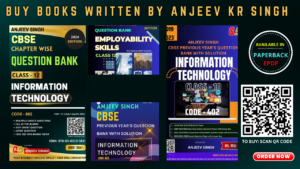Ch 11 Societal Impacts
Summary (A quick recap)
• Digital footprint is the trail of data we leave behind when we visit any website (or use any online application or portal) to fill-in data or perform any transaction.
• A user of digital technology needs to follow certain etiquettes like net-etiquettes, communicationetiquettes and social media-etiquettes.
• Net-etiquette includes avoiding copyright violations, respecting privacy and diversity of users, and avoiding cyber bullies and cyber trolls, besides sharing of expertise.
• Communication-etiquette requires us to be precise and polite in our conversation so that we remain credible through our remarks and comments.
• While using social media, one needs to take care of security through password, be aware of fake information and be careful while befriending unknowns. Care must be taken while sharing anything on social media as it may create havoc if being mishandled, particularly our personal, sensitive information.
• Intellectual Property Rights (IPR) help in data protection through copyrights, patents and trademarks. There are both ethical and legal aspects of violating IPR. A good digital citizen should avoid plagiarism, copyright infringement and trademark infringement.
• Certain software are made available for free public access. Free and Open Source Software (FOSS) allow users to not only access but also to modify (or improve) them.
• Cyber crimes include various criminal activities carried out to steal data or to break down important services. These include hacking, spreading viruses or malware, sending phishing or fraudulent emails, ransomware, etc.
• Excessive usage of digital devices has a negative impact on our physical as well as psychological well-being. Ergonomic positioning of devices as well as our posture are important.
NCERT Book Exercise Solution of Class 11 Computer Science
1. After practicals, Atharv left the computer laboratory but forgot to sign off from his email account. Later, his classmate Revaan started using the same computer. He is now logged in as Atharv. He sends inflammatory email messages to few of his classmates using Atharv’s email account. Revaan’s activity is an example of which of the following cyber crime?
Justify your answer.
a) Hacking
b) Identity theft
c) Cyber bullying
d) Plagiarism
Answer: (b) Identity theft
Identity theft means obtaining someone’s credentials to commit some online fraud.
2. Rishika found a crumpled paper under her desk. She picked it up and opened it. It contained some text which was struck off thrice. But she could still figure out easily that the struck off text was the email ID and password of Garvit, her classmate. What is ethically correct for Rishika to do?
a) Inform Garvit so that he may change his password.
b) Give the password of Garvit’s email ID to all other classmates.
c) Use Garvit’s password to access his account.
Answer: a) Inform Garvit so that he may change his password.
3. Suhana is down with fever. So, she decided not to go to school tomorrow. Next day, in the evening she called up her classmate, Shaurya and enquired about the computer class. She also requested him to explain the concept. Shaurya said, “Mam taught us how to use tuples in python”. Further, he generously said, “Give me some time, I will email you the material
which will help you to understand tuples in python”.
Shaurya quickly downloaded a 2-minute clip from the Internet explaining the concept of tuples in python. Using video editor, he added the text “Prepared by Shaurya” in the downloaded video clip. Then, he emailed the modified video clip to Suhana. This act of Shaurya is an example of —
a) Fair use
b) Hacking
c) Copyright infringement
d) Cyber crime
Answer: c) Copyright infringement
4. After a fight with your friend, you did the following activities. Which of these activities is not an example of cyber bullying?
a) You sent an email to your friend with a message saying that “I am sorry”.
b) You sent a threatening message to your friend saying “Do not try to call or talk to me”.
c) You created an embarrassing picture of your friend and uploaded on your account on a social networking site.
Answer: a) You sent an email to your friend with a message saying that “I am sorry”.
5. Sourabh has to prepare a project on “Digital India Initiatives”. He decides to get information from the Internet. He downloads three web pages (webpage 1, webpage 2, webpage 3) containing information on Digital India Initiatives. Which of the following steps taken by Sourabh is an example of plagiarism or copyright infringement? Give justification in support of your answer.
a) He read a paragraph on “ Digital India Initiatives” from webpage 1 and rephrased it in his own words. He finally pasted the rephrased paragraph in his project.
b) He downloaded three images of “ Digital India Initiatives” from webpage 2. He made a collage for his project using these images.
c) He downloaded “Digital India Initiative” icon from web page 3 and pasted it on the front page of his project report.
Answer: b & c
Plagiarism means using someone else’s work without giving adequate citation for use and presenting as your own work.
Copyright infringement means using copyright-protected material without obtaining copyright holder’s permission or without paying for it, if it is being sold.
6. Match the following:
| Column A | Column B |
| Plagiarism | Fakers, by offering special rewards or money prize asked for personal information, such as bank account information |
| Hacking | Copy and paste information from the Internet into your report and then organise it |
| Credit card fraud | The trail that is created when a person uses the Internet. |
| Digital Foot Print | Breaking into computers to read private emails and other files |
Answer:
| Column A | Column B |
| Plagiarism | Copy and paste information from the Internet into your report and then organise it |
| Hacking | Breaking into computers to read private emails and other files |
| Credit card fraud | Fakers, by offering special rewards or money prize asked for personal information, such as bank account information |
| Digital Foot Print | The trail that is created when a person uses the Internet. |

7. You got the below shown SMS from your bank querying a recent transaction. Answer the following —
a) Will you SMS your pin number to the given contact number?
Answer : No, I will not shared PIN to that contact number.
b) Will you call the bank helpline number to recheck the validity of the SMS received?
Answer : Yes. I will call the bank helpline number.
8. Preeti celebrated her birthday with her family. She was excited to share the moments with her friend Himanshu. She uploaded selected images of her birthday party on a social networking site so that Himanshu can see them. After few days, Preeti had a fight with Himanshu. Next morning, she deleted her birthday photographs from that social networking site, so that Himanshu cannot access them. Later in the evening, to her surprise, she saw that one of the images which she had already deleted from the social networking site was available with their common friend Gayatri. She hurriedly enquired Gayatri “Where did you get this picture from?”. Gayatri replied “Himanshu forwarded this image few minutes back”.
Help Preeti to get answers for the following questions.
Give justification for your answers so that Preeti can understand it clearly.
a) How could Himanshu access an image which I had already deleted?
Answer: Images loaded on a social networking site can be saved/downloaded or even screenshots may be taken.
b) Can anybody else also access these deleted images?
Answer: Yes, from the digital footprint, government and other agencies can obtain these legally, if needed.
c) Had these images not been deleted from my digital footprint?
Answer: Images deleted from a social website always remain part of a digital footprint.








